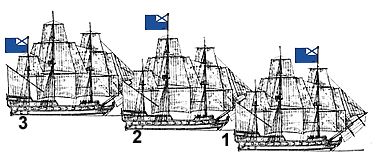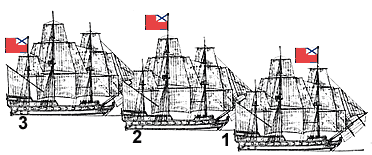Flag - Ship's Banner

Flags commanders
Russian Military Fleet
on the Sea Charter of 1720.
Charter Sea
Book Two
Chapter Three
About flags and lights and lanterns and body kits
According to the Charter, warships on which admirals, vice-admirals, Shutbainakhts, and in certain cases both captain-commanders and captains, must carry flags on their masts, indicating the presence on their ships of the respective chiefs and the duty of other ships to execute orders given signals from these ships.
The fleet, according to the Charter, was divided into three main squadrons (squadrons):
The first squadron was the vanguard (advanced forces) of the fleet. The color of the officers of this squadron is blue.
The second squadron was a corpsic battalion (the main forces of the fleet). The color of the officers of this squadron is white.
The third squadron was the rear guard (fleet cover from the rear). The color of the officers of this squadron is red.
Each squadron in turn was divided into three divisions:
The first division of the squadron - avant-garde squadron. She is commanded by a vice admiral. They were called the vice-admiral of the blue flag, the vice-admiral of the white flag, the vice-admiral of the red flag.
The second division of the squadron - the cordebatal squadron. This division and the entire squadron is commanded by the corresponding admiral - the admiral of the blue flag, the admiral of the white flag, the admiral of the red flag. But usually in the second division of the second squadron the general-admiral, commanding the entire fleet, held his flag on this ship. In this case, the admiral of the white flag was not appointed.
The third division of the squadron is the rearguard of the squadron. She commanded Shautbainaht. Accordingly, the Shautbainahty blue, white and red flag. Later, the name of this rank was replaced with the "Shautbainaht" to "Rear Admiral".
 The flags looked like this:
The flags looked like this:
1- General-Admiral's flag (standard)
2-flag squadron (avant-garde)
3-Flag Squadron (Cordebtalia)
4- Squadron Flag (rearguard)
5 Pennant Captain Commander
6 Pennant captain. (pay attention to the difference in ways of attachment to the mast of pennants captain-commander and captain).
The flags of admirals, vice-admirals and scoutbaynakhtov are identical in appearance. The difference is in which mast the flag is raised.
1-Ship Vice Admiral of the avant-garde. Flag on the foremast. 2- The ship of Almirala avant-garde. Flag on the mainmast. 3-ship of the avant-garde Shutbainakht. Flag on the mizzen mast.
1-Vice Admiral Cordebatal's ship. 2-ship of General-Admiral (in his absence on the main mast the flag of admiral cordebatalias is raised. In this case, he acts as general-admiral). 3-ship soutbainahta kordebatalii.
1-ship Vice Admiral of the rearguard. 2-Ship Admiral rearguard. 3-ship backyard rearguard.
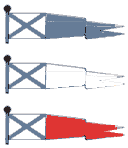 The captain commanders were the deputies of the corresponding admirals, vice-admirals, and Shautbainahts. If the corresponding flagship was not on the ship (departing from the ship, killed) and its duties were performed by the captain-commander, then instead of the flag on the mast at the same places (respectively on the foremast, mainmast, mizzen-mast) the pennant of the corresponding color was raised .
The captain commanders were the deputies of the corresponding admirals, vice-admirals, and Shautbainahts. If the corresponding flagship was not on the ship (departing from the ship, killed) and its duties were performed by the captain-commander, then instead of the flag on the mast at the same places (respectively on the foremast, mainmast, mizzen-mast) the pennant of the corresponding color was raised .
The figure shows the pennants of captains-commanders of the avant-garde, cordebatalia and rearguard.
If the captain-commander took command of a separate detachment, a group of ships, then a three-color pennant was raised on the mainmast (6).
If a regular ship was sent to perform an independent task, or the captain of this ship was entrusted with command of a group of ships, then the captain-commander tricolor pennant was raised on the main mast, but it was attached to the mast in a different way by the so-called "floating" method, rather than directly to the flagpole .
However, all these rules are valid under the condition that the ships are under the control of the corresponding flagship:
* General-Admiral of 15 ships and more;
* Admiral 13 ships and more;
* Vice-Admiral 7 ships and more;
* Shautbainaht 5 ships and more;
* Captain-Commander 3 ships and more.
If in submission of the flagship of the ships is less than indicated above, then this flagship and its younger flagships raise the flags on the mast, respectively, below the rank. For example, in a squadron of 10 ships. This means that the flag of the vice-admiral rises above the admiral ship, the flag of the Shautbainaht above the vice-admiral ship, and the captain-commander pennant over the shipbenaht ship. Those. flagships are reduced in rank if they do not command a sufficiently large number of ships. But this applies only to flags, but not the rights and privileges of the respective flagship, his official duties.
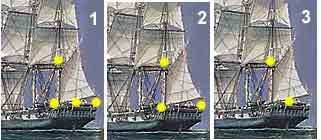 At night, when the flags are lowered, the ships carry lights:
At night, when the flags are lowered, the ships carry lights:
* General-Admiral, Admiral - three fires at the stern and one on Mars (1);
* Vice-Admiral - two fires at the stern and one on Mars (2);
* Shautbeinacht - one fire aft and one on Mars (3).
The rest of the ships do not carry lights.
 On particularly dark nights, the flagships carry the same lights, the rest carry one fire at the stern (4), with the scoutbainacht having double fire at the stern, but not on Mars (5).
On particularly dark nights, the flagships carry the same lights, the rest carry one fire at the stern (4), with the scoutbainacht having double fire at the stern, but not on Mars (5).
Unlike modern ships, the ships of that time did not carry on themselves other lights (running, hookah, top, etc.). There were no lights on the masts, on the nose, on the sides.
All of the above applies only to ships. For the galleys, the flags had a slightly different look (with braids) and several different colors.
The Maritime Charter was confirmed in 1763.
It is curious that the question of the place where there should be a naval flag is completely omitted in the Charter. It is as if warships should not carry a national naval flag at all, although the text of the Charter states that Russian warships should not lower their flag before anyone. Nowhere in the Charter is the Russian naval flag described, but the Kaiser-flag (güys) is described, but it is not written where and when güys rises. And this is despite the fact that Article 6 of the third chapter of the second book of the Charter clearly states that merchant ships of Russia are obliged to carry a tricolor flag (white-blue-red), but again, it is not indicated where.
The charter prescribes the use of a stern flagpole, where the naval flag is supposed to be, as a place for raising many flag signals. For example, "If the Admiral standard from the back of the flagpole dissolves and shoots once, then the Admirals or officers who have second and third place in the fleet have to go to his ship." Although, however, a number of signals rose on the gannel of the mizzen-mast, on the guys the mizzen-mast.
Obviously, the issue of a naval flag is either simply missed in the Charter, or there was another regulatory document for it; although it is very strange for the Statute - a document that even the toilet worker (profos) carefully drew up the duties.
A source
Book Charter marine. About all that concerns the good management of the fleet being on the sea. It was printed by the command of the Tsarist Majesty in the St. Petersburg Typography of the Lord's Day 1720 April in day 13
- 1st extra - A red rectangle with a white border on a blue background;
- 2nd additional - red oblique stripes on a yellow background;
- 3rd additional - repeats the guis of the Russian fleet, has a white border;
- 4th additional - four-part white-black-red-yellow triangular flag;
- - he repeated the guys of the USSR Navy (in the Russian Empire, of course, the imperial guys was used. In the table of 1901, he was assigned the meaning "I am going by special order. I cut through the system. Court of a special commission");
- - a black flag with a red triangle having a white border;
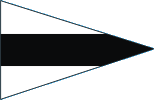


- - a white triangular flag with a black horizontal stripe;
- - A flag of yellow and blue vertical stripes. The “telegraph flag” itself is already present in the tables of 1901 and 1911, but there it is a blue cloth with 4 horizontal white stripes; This flag meant that the row of signal flags following it sends the phrase "by telegraph", i.e. one flag corresponds to one letter. If the "telegraph" flag was raised with a certain signal at the same time, but on a separate file, this meant that the entire signal should be read letter by letter. In the "Signaler's Handbook" N.S. Silver and B. B. Zhdanov (1983) states that the "telegraph" flag is also the first substitute flag.
- - A blue flag with a white rectangle in the center (it is already in the table of 1901); The flag is used to show that the ship uses signals from the Boat Signal Book. He, along with another flag is the call sign of the boat. In the "Signaler's Handbook" N.S. Silver and B. B. Zhdanov (1983) states that the “boat” flag is also the second substitute flag.

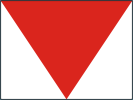

- - A white flag with a blue rectangle in the center; In the "Signaler's Handbook" N.S. Silver and B. B. Zhdanov (1983) states that the "air" flag is also the third substitute flag.
- - A white flag with a red triangle on top;
- - A white flag with a black triangle below;
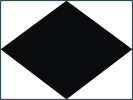
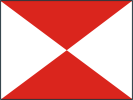
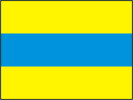

- - A white flag with a black diamond;
- - A flag divided by a slanting cross into red and white triangles;
- - flag of yellow, blue and yellow horizontal stripes; In the Russian Empire (1911 data), the question flag was different - a long blue pennant with a white luff. The question flag is raised simultaneously with the signal, but on a separate file, used to give the signal an interrogative form

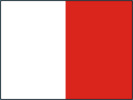
- - red trapezoid pennant with a white circle;
the vessel responding flag raises to half if a signal intended for it is noticed. When the signal is decoded, the response flag is raised "to the spot". If the destination ship receives several signals from different ships, it raises the response pennant together with the call signs of the ships that sent the signals. The response flag raised by the ship transmitting the signal also indicates that the signal is over. A separate raised single flag marks the end of the link. - - the flag divided vertically into the white and red halves;
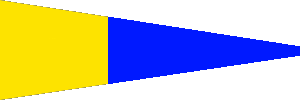

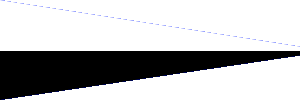

In the fleet of the Russian Empire, signal flags were also referred to as so-called. pilot flag - national tricolor flag with white border. Used to call the pilot.
Flag - "Yes" - yellow-blue pennant (available in the table in 1911);
Flag - "Not" - a rectangular white cloth with a black vertical stripe (available in the table of 1911);
"Compass flag" - a long yellow pennant with two blue triangles (available in the table of 1911);
"Duty Flag" - green triangular flag (available in the table of 1911);
"Cancellation flag" - a long pennant of white and black halves (available in the table of 1911);
"Prayer Flag" - a white flag with two braids and a yellow Orthodox cross (available in the table of 1911).Boat Signals

To negotiate warships with their boats, military boats between themselves, pre-draft boats, Osoaviahima ships (when they existed), and later DOSAAF ships used signals "Boat Signal Book" (first book of 1939, then a new edition of the SSC-70). Signals according to the Boat Signal Book were produced according to the Rules of Signal Production of PNS No. 2-39, later - in accordance with the Rules of Visual Communication and Signaling of the Navy (CCD-69). In order to show that negotiations are being conducted on the Boat Signal Book, a boat flag is raised on one of the ship’s feet. On the boats of such a flag does not rise, since they can only give signals on the "Boat Signal Book." Boat flag hoisted on a ship can also mean:
- together with one alphabetic flag hoisted above the boat in one halyard - the boat call sign. The boat's call sign raised on a ship indicates the requirement for the boat to approach the board on which the call sign is raised. If the boat belongs to another ship, then the call sign of this ship rises along with its call sign.
- in front of the signal, without call signs - “the signal is intended for all boats”.Below are the meanings of single flags according to the “Boat Signal Book”:
A - "I do not agree, do not destroy"
B - “More move. Greater harder. Add sails. Off the drift. "
B - “The course leads to danger”
G - Brandwacht
D - “Yes. I agree. Allow "
E - “What happened?”
F -
W - “I have a reverse gear. I'm drifting. Give reverse gear. Taben »
And -
K - "I can not be controlled"
L - “Keep left”
M - “Less move. Easier to warm. Turn down the sails "
H - “Cargo or I have a combat reserve”
ABOUT -
P - “Keep to the right”
R -
C - “Stop the car. Sushi paddles. Lie down in the drift.
T - “Keep it up”
Y -
F - Abolition
X - “End of teaching or occupation”
W - "Man overboard"
W -
Sh -
Kommersant - “The flagship (commander) shows the course”
Y -
B -
Uh -
YU -
I -
Figures - 1, 2, 3, 4, 5, 6, 7, 8, 9
0 - “Start of boat racing”
Nord - Rumb nord
Zuid - Rumb zuid
“Ost” - Rumb Ost
"West" - Rumb West
"Telegraph" - "I have an important assignment"
“Response pennant” - “I see clearly. Got it
“Boat” - “I am talking about boat book. Call signs of races "In the “Boat Signal Book”, a multitude of signals from two flags (alphabetic or numeric) is also given and decoded.
The source is "THE BOAT SIGNAL BOOK OF THE Navy OF THE UNION OF THE USSR", Ed. Quartermaster 1st rank A. Clafton. State Naval Publishing House NKVMF, Moscow, Leningrad, 1940
The report of the comrade minister of the sea forces of Chichagov dated May 24, 1804 (on which the resolution of May 25 “to be according to this” stands) contained information about the flags of the fleet and its organization. Chichagov writes that usually the fleet consists of 3 squadrons - the cordebatal, the guards and the rearguard, each of which is divided into 3 divisions. Three military flags - 1st white, 2nd blue, 3rd red. The 1st white flag uses the 1st squadron, the 2nd blue flag - the second squadron, the 3rd red flag - the third squadron.
The imperial standard (“fawn color”) on the grotto-nest, the Admiralty flag raised in the presence of the minister or deputies redeemed for review of the fleet, guis raised in the presence of the general admiral or the first admiral, if he is commanded by the entire fleet, have an advantage over these flags. .
Flagships:
The white flag - two senior admirals, three senior vice admirals, four rear admirals - the flags are raised on the mainmawl.
Blue flags - two admirals, three vice-admirals, four rear admirals - flags raise for form-sting.
Red flags - two admirals, three vice-admirals, four rear admirals - flags raise on a cruise-sténge.
Flagship ships have stern and flag flags of the color to which their flagships belong.
In particular ships - flags in color, consistent with the flags of squadron commanders.
All warships on the nose gyuys.
Huys or the admiralian flag rises no less than 15 ships, the admiral flag over 13, the vice admiral flag over 7, the rear admiral flag over 5, the captain-commander pennant over 3. But "if there are fewer ships, rather than flagships, the commander-in-chief can have both flags and their colors ... changing them according to the number of ships or according to circumstances. "
Breyd-pennants are two types: "Commander" - raised on the flagpole, and ordinary - floating. The captain commanders raised their colored braid pennants when they replaced the admiral's positions, while the color of the pennant and the place where it was raised was like the admiral's flag. If the captain-commander is sent with a detachment of ships from the port, then his braid-pennant is tricolor on the main-tree.
Pennants rise to the grotto-steng ships in colors according to squadron commanders. You can raise and on other stengah on the orders of the commander in chief. If, however, the captain of a private ship is sent with a separate detachment, then the pennant of a three-colored, floating boat.
On boats, admirals raise the same flags as on ships, but with the addition of bands along the bottom edge of the flag. And the captain commanders and captains raise the pennant, similar in color to squadron commanders.
Transport vessels carry white or blue flags, in the kryzha a white-blue-red flag, in a free field two crosswise laid anchors of blue or white colors.
Merchant ships carry white-blue-red flags.
Materials for the history of the Russian fleet. part 17, 1904
Under Alexander I, attention was drawn to the fact that it was impossible to raise the flag of the rear admiral on ships that did not have a mizzen-mast (he had to climb it on a mizzen-mast). In a document dated June 20, 1810, Admiral M. Traversa referred to the Emperor's command in such cases to raise the BATTLE rear admiral's flag on the cave.
In the future, this practice was fixed. The Maritime Statute of 1853 said, for example: "Article 954. The flag of the complete Admiral rises on the main-bram-stenge, the flag of the Vice-Admiral on the for-bram-topenge, and the flag of Counter-Admirala on the Kruis-bram-sentier. Note : On ships of the same mast, in order to avoid misunderstandings, the Vice and Rear Admirals raise the boat flags assigned to them. On the same two mast ships, only the Counter Admirals perform this, raising this flag on the for-bram-steenge. "
In 1865, it was decided that "all flagships should wear the same (Andrew's white) flag on all the flagships." True, the reservation was made that the color flags can be had by special instructions, when "by the considerable squadron composition" it will have to be divided into parts. [order of General Admiral Constantine number 98]
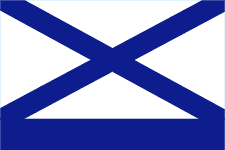
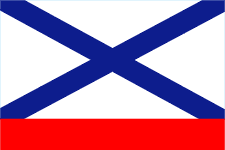
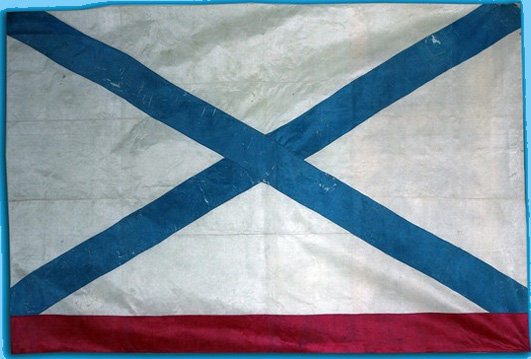
By order of the General Admiral of March 24, 1870 No. 46, the boat flags of the admirals were made to stand:
St. Andrew’s flag became the admiral’s stangy flag;
the vice-admiral's flag was distinguished by an additional blue stripe along the bottom edge;
and the flag of the rear admiral - an additional red stripe on the bottom edge.
These new adrenaline banners were no longer tied to a specific mast.
The materials of the Aksov Basil archaeological archive (Minsk) were used. Photo of the admiral's flag of the 19th century from the funds of the Central Naval Museum.
The order of signaling flags.
International Code of Signals.
The International Code of Signals (MSS) is intended primarily for communication with foreign ships and vessels in an environment caused by the need to ensure the safety of navigation and the protection of human life at sea, especially in cases when there are language difficulties in communication. The code allows signal production by all means of communication, including a radiotelephone and radio telegraph. It is built on the principle that each signal has a complete semantic meaning. In some cases, digital extensions are used to expand the value of the main signal. As a rule, only one flag signal should be raised at a time. Each signal or group of signals must remain raised until a response appears on the receiving ship.
Call the ship.
The call signs of the called vessel should be raised simultaneously with the signal on a separate file.
If the call signs are not raised, it means that the signal is addressed to all ships located within the visibility range of the signals. If it is impossible to establish the call sign of the vessel to which you need to send a signal, then you should first raise the VF signal - “You must raise your call sign” or CS - “What name or call sign of your vessel?”. At the same time, the transmitting vessel raises its call signs.
Response to signals.
All ships to which signals are addressed or which are indicated in the signals, as soon as they see them, should raise the “Response pennant” to half, and immediately after parsing the signal - to the place; The “response pennant” should be lowered to half as soon as the transmitting station lowers the signal, and raised again to the place after the next signal is parsed.
The end of the exchange of signals.
After the last flag signal has been lowered, the transmitting vessel must separately raise
"Response pennant", indicating that this signal is the last. The receiving vessel must respond to this in the same way as all other flag signals.
Actions if the signal is not clear.
If the receiving ship cannot distinguish the signal transmitted for it, then it should keep the Response Pennant raised to half. If the signal is distinguishable, but its meaning is not clear, then the receiving vessel can raise the signal: ZQ - "Your signal seems to be encoded incorrectly. You should check and repeat the entire signal" or ZL - "Your signal is received, but not understood."
Use replacement pennants.
The use of replacement pennants allows repeating the same alphabetic flag or numeric pennant one or several times in the same group, if the ship has a single set of flags. The first replacement pennant always repeats the topmost signal flag of the first signal combination; the second replacing one always repeats the second one, and the third replacing one - the third above the signal flag. A replacement pennant can never be used more than once in the same group. A “response pennant” when applied as a decimal point should not be taken into account when determining which surrogate to use.
Spell.
The names of the ships or geographical objects in the text of the flag signal should be given by the letters of the Latin alphabet. With non-military ships, the military can exchange messages on the International Code of Signals. In this case, the ship raises the red and white pennant of the International Code of Signals.
The signals of the vault, with the exception of showing the action of the ship, are transmitted flag
alarm in the following order:
- The flagship sends signals through the connection without the call sign of the addressee and the sender;
these signals rehearse all the ships of the compound with flags;
- A flagship sends signals to one ship or several ships only with the addressee’s call sign (s); these signals are rehearsed with flags by ships that are at the shortest distance between the sender and the addressee;
- Ships of connection signals to one ship (including the flagship) or
several ships are transmitted with the call sign of the addressee and the sender; these signals
flags rehearse ships that are at the shortest distance between the sender and the addressee;
- Connection ships, signals that are a report to the flagship and at the same time notification of the connection ships, are transmitted only with their call signs; these signals are rehearsed with flags all the ships of the compound.
Signal rehearsal
Rehearsing the signal flags is performed in the following sequence:
- the sending ship raises the signal to the place;
- ships rehearsing the signal raise it to half;
- the destination ship raises the signal to the place; after that the ships rehearsing the signal
lift him too to the place.
The signal descends all the ships, following the actions of the flagship.
The order of transmission of signals showing the actions of the ship.
Signals showing the ship’s actions are transmitted without the sender’s call sign and not
rehearsing.
Raise and descend flags colorization.
With the ceremonial raising of the Russian Navy flag, stitched flags and colorization flags are raised. Steng flags rise on the stengs of all the masts; at the same time, the flags of officials raised on them should be located below the stingy flags. Flags of ships are painted between the masts of the mast and from the last to the stems of the ship. From the stem to the mast of the foremast, triangular flags are raised, between the mast mats — rectangular, from the mast, main-or mizzen-mast to the stern pole — triangular and rectangular with kosits.
When coloring are not used:
- State flag
- flags of auxiliary vessels and ships of the border troops;
- Huys;
- flags and brand pennants of officials, pennant;
- foreign national, military, trade flags and flags of officials;
- flags of the signal set, having the same pattern with foreign national
flags; these flags currently include flags: B, K, H, R, X, C, E
Executive, 3, 4, 7, 9.
The set of flags for lifting during colorization should be made so that the raised flags or their individual signals do not form any phrases or words with their literal values. The colorization flags are raised on the files specially prepared for this purpose.
Original notes and comments on
Flag - Ship's Banner
Raised on a ship of the Navy, the national flag of the country is a symbol of state sovereignty, and the naval flag is the battle flag of the ship. Each ship has a set of a wide variety of flags. Each of them climbs to a mast under precisely regulated circumstances and at clearly defined places. In this case, everything has a strictly defined value. Each flag has its own history of origin.
Their birth began at the earliest stages of shipbuilding and navigation. The image of ship flags archaeologists found even in ancient Egyptian frescoes. Ship flags of ancient times served as distinctive signs, symbols of the economic power of the owner. The richer a man was, the more luxuriously he decorated his ship with flags. For example, in the middle of the XIV century. It was considered a special chic to raise a huge flag on a ship.
The Duke of Orleans, who commanded the French fleet in 1494, had its own standard. Its length was 25 m. The flag was made of yellow and red taffeta. On each side on the background of a silver cloud placed the image of the Virgin. Pennants and flags of King Henry VIII were embroidered with gold.
On medieval ships, the number of flags reached a dozen. They were installed on masts, on the stern, bow, and even side flagpoles. However, over time, their number decreased. Flags began to lift only on the bow of the stern and masts. Thanks to them, the crews distinguished their ships from the enemy during battles, and also determined the location of the admirals commanding squadrons.
With the development of warfare at sea, flagship, admiral, and captain flags appeared, and later flags signaling the vanguard, corpsy battalion, rearguard, that is, units of battle formation in which warships fought. When on board the ship was a significant official, raised a special flag.
For a long time, each crew had signal flags, each of which had a definite letter or special meaning. By typing in two, three or four flags of this type, raised on the screen, the team could transmit any message in encrypted form. Nowadays, most signal flags have a rectangular shape, but there are triangular as well as long flags. Most of the ship's flags are sewn from flagdukha - a special lightweight woolen fabric.
The formation of sovereign states led to the emergence of national flags. Thus, each ship leaving its state was obliged to raise the flag of its homeland. When the fleet was divided into military, transport, cargo, etc., the flag began to distinguish not only belonging to a particular state, but also the purpose of the ship.
In Russia, ship flags appeared long before the formation of a centralized state. Even on the boats, the Russians raised, as a rule, two flags. One had a rectangular shape. The other was with a corner cut on the outside, i.e. with braids. Flags of this type later became an integral part of Cossack gulls and planes.
But historians link the beginning of the history of the Russian flag of the ship with the construction of the first warship "Eagle". At the behest of Peter the Great, he wore a white-blue-red flag with a double-headed eagle sewn on it. Some researchers believe that it was not only the first national maritime flag, but also the first standard.
Standard appeared in the fleet in the first quarter of the XVI century. He was the flag of the head of state and was raised on the mast-mast of the ship when the king or emperor was on board. At first, standards were made of expensive brocade fabrics, embroidered with gold, silver and decorated with precious stones. But in the middle of the XVI century. they began to depict state emblems - symbols of power.
In 1699, Peter I introduced a new royal standard, which was a yellow rectangular panel with a black double-headed eagle in the middle and with white maps of the Azov, White and Caspian Seas in the keys and in one of the legs. When Russian troops captured the Nyenskans Fortress, thanks to which Russia acquired access to the Baltic Sea, a map of this sea also appeared on the royal standard.
The history of the emergence of the Russian coat of arms in the form of a two-headed eagle, which became part of the standard, began in 1472. The Grand Duke of Moscow Ivan III was married to the niece of the last emperor of Byzantium, Constantine XI. This event contributed to the proclamation of the Russian state successor to the Byzantine Empire. In connection with this, the Byzantine coat of arms, a double-headed eagle, came to Russia. He was not borrowed, but was a logical continuation of the Grand Duke’s inheritance in Moscow from the title of governor of the Eastern state.
On the ship's standard of the Russian Empire at the beginning of the XX century. The coat of arms was depicted as a black double-headed eagle crowned with three crowns, holding in its paws signs of state power — a scepter and orb. On the chest of the eagle was the Moscow coat of arms with the image of St. George the Victorious striking the dragon. The emblem shield twisted the chain of the Order of St. Andrew the First Called. On the wings of the eagle and around it were located the symbols of kingdoms, grand principalities and lands that were part of the Russian state. The coat of arms also depicted saints Michael and Gabriel and the imperial canopy with the inscription: "God is with us." Above it was a state gonfalon with an eight-pointed cross on a pole.
In 1699, Peter I introduced a single flag for all warships. The St. Andrew’s naval flag was a rectangular three-strip white-blue-red color. On it were depicted the rays of a blue diagonal cross. The choice of St. Andrew's cross as the emblem for the flag Peter I explained by the fact that it was from this apostle that Russia received holy baptism.
In 1700, at the direction of the emperor, the sailing fleet was divided into three general squadrons — the corps-battalion, the vanguard, the rear-guard — and they introduced the corresponding flags — white, blue, and red with blue. In 1710, a new design of the stern flag was approved. The center of St. Andrew's cross was still in its center, but its ends did not reach the edges of the cloth. Under this flag, the battleship of the Baltic fleet Poltava set off for its first voyage.
In 1712 the blue cross of the St. Andrew’s flag was brought to the edge of the cloth. This image existed without any changes before the October Revolution. After the coup d'état of 1917, all the symbolism of the former Russian Imperial Navy was canceled.
On November 18 of the same year, at the First All-Russian Congress of the Navy, a decision was taken to raise the flag of the International, which was a red cloth without emblems and inscriptions, on ships instead of St. Andrew's.
From April 20, 1918, a red flag with the abbreviation of the RSFSR was introduced on Soviet ships. In 1920, the Soviet government legalized the new flag of the navy. He had two braids, and in the middle of the cloth was a large blue Admiralty anchor, on the spindle of which there was a five-pointed red star, inside the star there were blue sickle and a hammer. On the stem of the anchor was the inscription: "RSFSR".
In 1923, they introduced a new flag of the Navy. In the middle of the red cloth was placed a white circle with eight white rays, diverging in all directions from the center to the edges. A red five-pointed star with white crossed sickle and a hammer was placed in the white circle. In 1926, the Soviet government established a special flag. They were awarded ships or formations for special merits. Unlike the usual Honorary revolutionary naval flag made of silk. In its upper left corner depicted the Order of the Red Banner. The ships and formations awarded with this flag began to be called the Red Banner.
In 1935, the designs and colors of the new flags of the Navy ships were approved (they were used until January 1992). In the same year, some changes appeared in the design of the Honorary Revolutionary Naval Flag of the USSR. The flag of the new type, the Red Banner of the USSR Naval flag, was a panel of rectangular shape. In its left half a five-pointed star was depicted, and in the right half there were crossed sickle and hammer of red color. Along the bottom edge of the cloth there was a blue border. The star of the Red Banner Naval Flag was overlapped by the image of the Order of the Red Banner.
June 19, 1942 was established the Guards Naval Flag of the USSR. It was assigned to ships for special differences. Since then, the warship wore the title of the Guard. On the flag panel above the blue border, an additional Guards tape was displayed, consisting of three black and two orange stripes.
Every day all the auxiliary ships and warships at the certain time were raised on the stern flagpole in the morning, and with the setting of the sun the naval flag was lowered. While stationing on combat vessels of I, II, III ranks, a pois was raised and lowered simultaneously with the flag. While at sea, the ships set the flag on the gaff and did not let it go until they returned to the base.
The charter of the ship clearly defined the order of ascent, descent and presentation of the Naval Flag. Every day at eight in the morning local time, and on weekends, an hour later on all the ships of the Navy, in accordance with the ritual regulated by the ship’s charter, raised the flag. For the first time this procedure was outlined by Peter I in the maritime charter:
"... In the morning, first of all, you should shoot from a cannon and guns, then play on all ships march, beat the march, raise the flag, and play the standard zlro by raising the flag, .. Whatever time the flag is raised and lowered, It should be both when raising and lowering it, beat the bans of the march and play the march to the bars ”. The flag ritual was performed in a similar way, i.e., the evening “Dawns”. During the long history of the national fleet, the procedure of raising and lowering the flag has undergone many changes.
During the Great Patriotic War, the protection of the ship's banner in battle was a sacred duty for all sailors. If the enemy managed to knock down the flag, then he was immediately replaced by another, so that the enemy could not assume that the crew was surrendering.
There are many examples when courageous Russian sailors died along with the ship’s banner high on the masts. For example, on August 10, 1941, in an unequal battle with several German destroyers on the patrol ship “Fog” a flagpole was shot down. The heavily wounded sailor Konstantin Semenov picked up the fallen flag and raised it high above his head. However, an enemy shard struck down the hero, and he fell to the deck. The radio operator Konstantin Blinov arrived in time to help the sailor. Under the fierce fire of the Nazis, they again raised the ship's banner. Soon the depths of the sea swallowed up "Fog", which never let down its flag.
On August 25, 1942, in the Kara Sea, the fascist cruiser Admiral Scheer overtook the icebreaking steamer Alexander Sibiryakov armed with only a few small cannons. The Nazis did not doubt the easy victory and gave a signal for the Soviet ship to lower its ship's banner and surrender. In response, our sailors raised the flag of the flag and opened the fire with 76-mm and 45-mm guns at the enemy. For the first moment, the command of the cruiser "Admiral Scheer" froze in confusion. Then the Nazis opened heavy fire on the Soviet ship. Senior Lieutenant Anatoly Ka-charava, commander of the icebreaker steamer, skillfully maneuvered, avoiding direct enemy hits. However, the forces were unequal, and the heroic crew of the Alexander Sibiryakov was killed along with his combat vessel, but he did not lower the flag in front of the enemy.
In addition to the Naval Banner, the pennant plays an important role in the life of the ship and its crew - a long and narrow flag that looks more like a colored ribbon winding among a mast and rigging. It rises on a warship, if by its technical condition and the level of preparedness of the crew it is able to successfully solve its combat missions.
The story of the appearance of pennants goes into the distant past of the fleet. At first, attached to the tops of the masts, narrow flat fabrics served as the simplest instrument for determining the direction and strength of the wind. In times of sailing ships, the pennant served as the distinction between a warship and a merchant ship. This type of flag was raised on all warships except flagships. It was a narrow cloth up to 10 m long and 10-15 cm wide.
Pennants of the first domestic combat ships were white-blue-red and with two braids. In 1700, Peter I introduced a new pennant drawing: on the pillar adjoining the falu on the white field a blue St. Andrew’s cross was depicted, then two white-blue-red braids were placed.
Soviet warships wore a pennant, which was a narrow red cloth with braids. In the Navy also braid pennants were adopted. They were assigned to the commanders of detachments of warships, which had a rank below the rear admiral. Breyd pennants practically did not differ from usual. Only the color of the braids depended on the position of the chief to which he was assigned: the commander of the brigade of the ships was red, the commander of the division was blue.
On large warships, when anchored, on a barrel or at the pier, a special flag was hoisted on the bow flagpole - guis. It was introduced in the Russian fleet in 1700. From 1701 to 1720 it was raised only above the coastal fortresses, and only after the introduction of the charter in 1720 it was installed on the bowsprit of military courts.
Huyus, founded by Peter I, was used in the Soviet fleet until August 28, 1924. However, his design changed slightly. In the middle of the panel there was a white circle, in which a red five-pointed star was depicted with white crossed sickle and a hammer in the center. In 1932 a new guis was introduced. It was a rectangular red cloth, in the center of which, in a white edging, an image of a red five-pointed star with a sickle and a hammer was placed.
In 1992, the Russian government adopted a resolution abolishing Soviet naval symbols. On July 26 of the same year, on Navy Day, on warships, to the sounds of the anthem of the Soviet Union, the flags of the Soviet Navy were lowered and handed over to commanders for permanent storage. Instead of them, accompanied by the anthem of the Russian Federation, raised the legendary St. Andrew’s flags and guys, established by Peter I.

 Live journal
Live journal Facebook
Facebook Twitter
Twitter